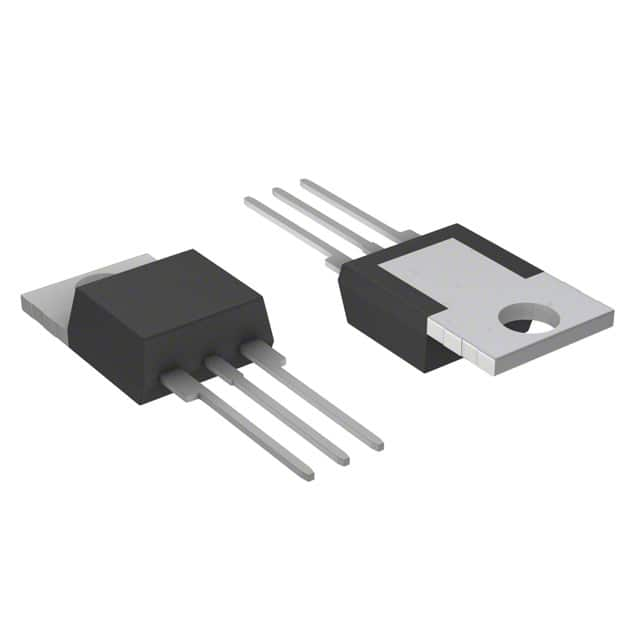Consulte las especificaciones para obtener detalles del producto.

Q4010R5 Product Overview
Introduction
The Q4010R5 is a semiconductor device belonging to the category of thyristors, commonly used in power control applications. This entry provides an overview of the basic information, specifications, pin configuration, functional features, advantages and disadvantages, working principles, application field plans, and alternative models of the Q4010R5.
Basic Information Overview
- Category: Thyristor
- Use: Power control applications
- Characteristics: High current capability, low conduction loss, fast switching speed
- Package: TO-220AB
- Essence: Silicon-controlled rectifier (SCR)
- Packaging/Quantity: Typically packaged individually
Specifications
- Voltage Rating: 400V
- Current Rating: 10A
- Gate Trigger Current: 5mA
- Operating Temperature Range: -40°C to 125°C
- Mounting Type: Through Hole
- Package / Case: TO-220-3
Detailed Pin Configuration
The Q4010R5 has a standard TO-220AB package with three pins: 1. Anode (A) 2. Cathode (K) 3. Gate (G)
Functional Features
- High Current Capability: Capable of handling high currents for power control applications.
- Low Conduction Loss: Efficient conduction characteristics leading to minimal power loss.
- Fast Switching Speed: Enables rapid switching between on and off states for precise power control.
Advantages and Disadvantages
Advantages
- Reliable power control solution
- Low conduction loss
- Fast switching speed
Disadvantages
- Sensitive to voltage transients
- Requires careful gate triggering to avoid unintended activation
Working Principles
The Q4010R5 operates based on the principle of controlling the flow of current through the anode-cathode path using gate triggering. When the gate current exceeds the specified threshold, the device enters a conductive state, allowing current to flow until turned off.
Detailed Application Field Plans
The Q4010R5 finds extensive use in various power control applications, including: - AC motor control - Lighting control - Heating control - Power supplies - Industrial automation
Detailed and Complete Alternative Models
Several alternative models to the Q4010R5 include: - Q6010R5: Higher voltage rating variant - Q2010R5: Lower current rating variant - Q4010R3: Different package variant
In conclusion, the Q4010R5 serves as a reliable and efficient thyristor for power control applications, offering high current capability, low conduction loss, and fast switching speed. Its working principles and application versatility make it a valuable component in various industries.
Word Count: 366
Enumere 10 preguntas y respuestas comunes relacionadas con la aplicación de Q4010R5 en soluciones técnicas
What is Q4010R5?
- Q4010R5 is a specific model of thyristor, commonly used in power control applications.
What are the key specifications of Q4010R5?
- The Q4010R5 thyristor typically has a voltage rating of 400V and a current rating of 10A.
What are the typical applications of Q4010R5?
- Q4010R5 is often used in AC switching and power control circuits, such as in dimmer switches, motor speed controls, and heating control systems.
How does Q4010R5 compare to other similar thyristors?
- Q4010R5 offers a good balance of voltage and current ratings, making it suitable for a wide range of medium-power applications.
What are the important considerations when designing with Q4010R5?
- It's crucial to consider heat dissipation, voltage and current ratings, and proper triggering mechanisms when integrating Q4010R5 into a circuit.
Can Q4010R5 be used in high-temperature environments?
- Q4010R5 has a maximum operating temperature of around 125°C, so it should be used within specified temperature limits.
Are there any common failure modes associated with Q4010R5?
- Overvoltage or overcurrent conditions can lead to failure, so protective measures such as snubbers or fuses may be necessary.
What are the typical control signals used with Q4010R5?
- Q4010R5 can be triggered by applying a gate current, which can come from various sources such as microcontrollers, timers, or sensors.
Can Q4010R5 be used in both AC and DC circuits?
- Q4010R5 is primarily designed for AC applications, but it can also be used in some DC control circuits with appropriate considerations.
Where can I find detailed application notes and reference designs for Q4010R5?
- Application notes and reference designs for Q4010R5 can often be found in the datasheet provided by the manufacturer, as well as in technical forums and industry publications.

